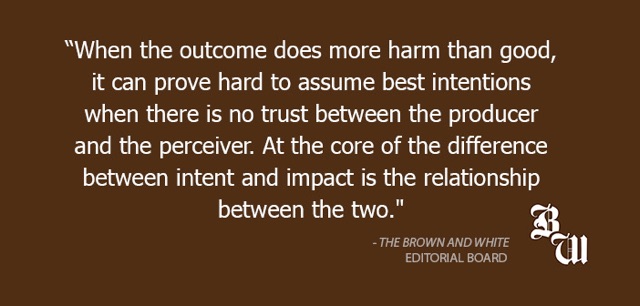We’ve all heard the saying: “The road to hell is paved with good intentions.”
Oftentimes, people make decisions with good intent that have a different impact. This can happen when decisions are not thoroughly thought out or discussed in full and can lead to some pretty detrimental outcomes.
The creation of a Non-POC (People of Color) Cafe at University of Michigan-Dearborn “to discuss their experience as students on campus and as non-POC in the world” is an example of one of those poorly thought-out decisions.
In an apology issued by the university, Chancellor Domenico Grasso stated, “Our opportunity to create meaningful and consequential conversation was lost.”
University of Michigan-Dearborn claimed the creation of this virtual discussion space was intended to provide students with a space to reflect on their lived experiences and have important race-related discussions.
In concept, this is not a horrible idea by any means. There’s a serious possibility that the creators intended to have this space be one to discuss white privilege and other topics related to recognizing one’s own race-provided advantages.
However, the framing and presentation of this was misconstrued as a whites-only club.
Now, while this may be an extreme case, UMich-Dearborn does not stand alone. Lehigh University has also had incidents of seemingly well-placed intentions that have produced insensitive impacts.
For example, back in June, a mural honoring George Floyd was erected on campus. The following day, Lehigh had the art removed. When a similar mural appeared again for a second time, Lehigh once more removed the artwork, perhaps with the intention to keep graffiti off of campus property. .
However, the impact that this had was one of insensitivity and reflected poorly on the administration’s part, coming off as an attempt to clamp down on the Black Lives Matter movement.
While the examples we have cited up to this point directly involve race-related incidents, the issue of well-intended causes backfiring in actuality can be applied to a much larger scale. They occur in everyday encounters as well on the institutional level. It is on us to learn how to best think through our actions and decisions prior to making them in order minimize inconsiderate outcomes.
The business management company, Tolero Solutions, specializes in communication and building leadership skills. In its report on the differences between impact and intent in how people communicate, Toler Solutions cites building trust, listening with an open mind and owning up to your mistakes as the three biggest components in rectifying poorly communicated intentions.
It is crucial that we keep top of mind how we think through what we say before we act and that we understand the difference between intent and impact.
Sometimes intentions have more harm than good. When assumptions about what is best for someone is made without open communication, interpretation is left up to the perceiver.
Intentions do not make a story, perception — or impact — makes a story. There are many avenues on the journey between intent and impact where the idea can diverge from its path.
When the outcome does more harm than good, it can prove hard to assume best intentions when there is no trust between the producer and the perceiver. At the core of the difference between intent and impact is the relationship between the two.
If you improve the relationship, then one can get to know the other better, which would allow for more positive impacts and easier assumption of best intentions.
As a student publication, we understand that our role in representing voices of the university and holding powerful institutions accountable comes with great responsibility. Before reporting on topics that have the ability to spark controversy or cause conflict, we have to carefully consider the pros and the cons related to the story. We have to consider our craft carefully on how we flesh out these topics and make sure we take every relevant perspective into account in our reporting.
There are times when we hit the nail on the head, and there are times where we fall short. Just look at our comments section.
But at the end of the day, it is all a learning curve.






Comment policy
Comments posted to The Brown and White website are reviewed by a moderator before being approved. Incendiary speech or harassing language, including comments targeted at individuals, may be deemed unacceptable and not published. Spam and other soliciting will also be declined.
The Brown and White also reserves the right to not publish entirely anonymous comments.
1 Comment
What is popular or favored by the majority is not necessarily the best; nor is what is favored by those in power the best.
“When assumptions about what is best for someone is made without open communication, interpretation is left up to the perceiver. Intentions do not make a story, perception — or impact — makes a story.” “For example, back in June, a mural honoring George Floyd was erected on campus. The following day, Lehigh had the art removed. When a similar mural appeared again for a second time, Lehigh once more removed the artwork, perhaps with the intention to keep graffiti off of campus property. Could it be there was not open communication with the administration about the mural? Could the perception of the administration create an impact that was not considered by muralists?
“The road to hell is paved with good intentions.” is a useful quote but not in this editorial; the sense of the quote relates to intentions to do good versus actual actions to accomplish good. Intentions are often very important in determining whether an action was planned to harm or planned to aid but performed inadequately. Perception may concentrate on the harm but the intent needs to be taken into account. Ignoring the intent may create conflict and prevent communication.
Intent is critical in decisions and is so important that is often hidden in hopes that a beneficial outcome will hide a devious intent. In this instance poorly communicated intentions may be a goal.
I am pleased that your intent is: “… make sure we take every relevant perspective into account in our reporting.”; accomplishing that should go a long way in producing worthwhile impacts.